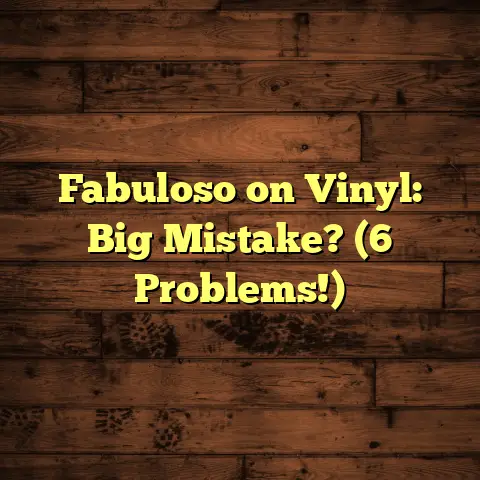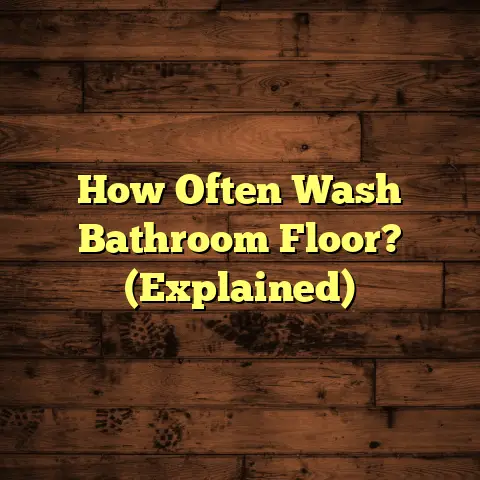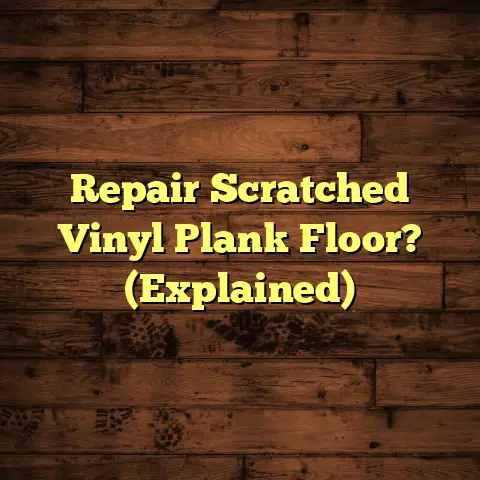Epoxy Garage Floor (DIY): Video (4 Steps Missing?)
I’m a flooring contractor with years of experience, and I’ve seen firsthand how epoxy can transform a dull, concrete slab into a showroom-worthy surface.
It’s not just about looks, though. Epoxy floors are tough, easy to clean, and can handle just about anything you throw at them (or spill on them!).
DIY projects are all the rage these days, and epoxy flooring is a popular one. There’s a real sense of satisfaction in doing it yourself and saving money, but it’s crucial to do it right.
I’ve seen tons of videos online promising easy epoxy installations. But honestly, many of them skip over some really important steps.
That’s why I’m writing this – to give you the complete picture and help you avoid common DIY pitfalls. Let’s dive in and make sure your garage floor turns out amazing!
Section 1: Understanding Epoxy Flooring
Okay, so what is epoxy flooring anyway?
Basically, it’s a thermosetting polymer formed by mixing an epoxy resin with a hardener (also called a catalyst).
When these two components combine, a chemical reaction occurs, creating a rigid, durable plastic material. It’s this chemical reaction that gives epoxy its amazing properties.
There are several types of epoxy flooring systems:
-
100% Solid Epoxy: This is the highest quality, most durable option. It contains no solvents, so it shrinks very little during curing. It’s also the most expensive.
-
Water-Based Epoxy: These are easier to apply and have lower VOCs (volatile organic compounds), making them more environmentally friendly. They’re generally less durable than 100% solid epoxy.
-
Solvent-Based Epoxy: These offer good durability and adhesion, but they contain solvents that can be harmful to your health and the environment. They’re also becoming less common due to stricter regulations.
For a garage setting, epoxy is fantastic. Here’s why:
-
Resistance to Stains: Oil, grease, chemicals – epoxy can handle it all. Just wipe it up!
-
Chemical Resistance: It’s resistant to many common chemicals found in garages, like gasoline, brake fluid, and antifreeze.
-
Abrasion Resistance: It can withstand heavy foot traffic, dropped tools, and even vehicle tires.
-
Durability: When properly installed, epoxy floors can last for years, even decades.
And let’s not forget the aesthetics! You have so many options:
-
Color Choices: From basic grey to vibrant blues and reds, you can find an epoxy color to match your style.
-
Textures: Additives can create a non-slip surface, which is especially important in a garage.
-
Decorative Flakes: These come in various colors and sizes and add visual interest and texture.
-
Metallic Pigments: These create a stunning, three-dimensional look that’s sure to impress.
I once worked on a garage where the homeowner chose a metallic blue epoxy with silver flakes. It looked like something out of a sci-fi movie!
Section 2: The DIY Process of Installing Epoxy Flooring
Okay, let’s talk about the DIY aspect. I get it – installing an epoxy garage floor yourself can save you a lot of money. The appeal is strong!
The basic steps are pretty straightforward:
-
Preparation: This is the most crucial step. You need to clean, repair, and prepare the concrete surface.
-
Application: Mixing and applying the epoxy is where the magic happens.
-
Curing: This is the waiting game. Let the epoxy harden properly.
Here’s a list of tools and materials you’ll need:
-
Safety Gear:
- Gloves
- Eye protection (goggles or safety glasses)
- Respirator (especially for solvent-based epoxies)
- Old clothes or coveralls
-
Preparation Tools:
- Concrete cleaner/degreaser
- Concrete patch or repair compound
- Concrete grinder or etching solution
- Shop vacuum
- Scraper
- Wire brush
-
Application Tools:
- Mixing buckets
- Drill with mixing attachment
- Squeegee
- Roller with epoxy-resistant roller covers
- Spiked shoes (for walking on wet epoxy)
- Painter’s tape
-
Cleaning Supplies:
- Mineral spirits or epoxy cleaner
- Rags
Don’t skimp on the safety gear. Epoxy can be irritating to the skin and respiratory system.
Section 3: Missing Elements in the Video Guide
Alright, let’s get to the heart of the matter: those missing steps in the DIY videos. I’ve watched so many of these, and it’s surprising how often crucial details are left out.
Here are four critical steps that are often glossed over or completely ignored:
Step 1: Surface Preparation
This is the most important step. I can’t stress this enough. If you don’t prepare the surface properly, the epoxy won’t adhere correctly, and you’ll end up with peeling, bubbling, and a whole lot of frustration.
Cleaning: Start by thoroughly cleaning the concrete surface. Use a concrete cleaner/degreaser to remove any oil, grease, dirt, or other contaminants. Scrub the surface with a stiff brush and rinse thoroughly.
Repairing Cracks: Fill any cracks or holes with a concrete patch or repair compound. Follow the manufacturer’s instructions carefully. Let the patch dry completely before moving on.
Etching: This is where many videos fall short. Concrete is naturally smooth, which makes it difficult for epoxy to adhere. Etching creates a rough surface that the epoxy can grip onto.
There are two main ways to etch concrete:
-
Concrete Grinder: This is the most effective method. A concrete grinder with a diamond grinding wheel will remove a thin layer of the concrete surface, creating a rough profile. You can rent these from most tool rental stores.
-
Etching Solution: This involves applying an acid- based etching solution to the concrete surface. Follow the manufacturer’s instructions carefully. Be sure to wear appropriate safety gear, as these solutions can be corrosive.
After etching, rinse the surface thoroughly with water and let it dry completely. Use a shop vacuum to remove any remaining dust or debris.
Why is this missed?
Surface preparation is labor-intensive and not visually appealing for a video. It also requires specialized equipment, which some DIYers may not have.
Step 2: Proper Mixing Techniques
Epoxy is a two-part system: the resin and the hardener. Mixing these two components in the correct ratio is essential for a proper chemical reaction.
If you don’t mix them correctly, the epoxy may not cure properly, resulting in a soft, sticky, or brittle finish.
Accurate Measurement: Use measuring cups or a scale to ensure that you’re using the correct ratio of resin to hardener. Follow the manufacturer’s instructions precisely.
Thorough Mixing: Use a drill with a mixing attachment to mix the resin and hardener thoroughly. Scrape the sides and bottom of the bucket to ensure that all of the components are fully incorporated.
Mixing Time: Mix for the recommended amount of time, usually 2-3 minutes. Don’t overmix, as this can introduce air bubbles.
Pot Life: Be aware of the epoxy’s pot life. This is the amount of time you have to work with the epoxy after it’s been mixed. After the pot life expires, the epoxy will start to harden in the bucket.
Why is this missed?
Mixing epoxy seems simple, but the nuances are critical. Videos often show a quick mix without emphasizing the importance of precise ratios and thoroughness.
Step 3: Application Techniques
Applying epoxy evenly and consistently is crucial for a professional-looking finish. Here are some tips:
Pouring: Pour the mixed epoxy onto the prepared concrete surface in a ribbon pattern.
Spreading: Use a squeegee to spread the epoxy evenly across the surface. Work in small sections to ensure that you don’t miss any spots.
Back Rolling: After spreading the epoxy with a squeegee, use a roller with an epoxy-resistant roller cover to smooth out the surface and remove any air bubbles.
Spiked Shoes: If you’re applying multiple coats or adding decorative flakes, wear spiked shoes to walk on the wet epoxy without leaving footprints.
Avoiding Bubbles: Air bubbles can ruin the finish of your epoxy floor. To minimize bubbles:
- Ensure the concrete is properly prepared and sealed.
- Mix the epoxy thoroughly but avoid overmixing.
- Use a roller to remove any bubbles that do appear.
- Consider using a heat gun to pop stubborn bubbles.
Why is this missed?
Application techniques require practice and can be difficult to demonstrate in a short video. Videos often focus on the speed of application rather than the quality.
Step 4: Curing Process
The curing process is the final step in the epoxy installation. During this time, the epoxy hardens and develops its full strength and durability.
Curing Time: The curing time will vary depending on the type of epoxy, the temperature, and the humidity. Follow the manufacturer’s instructions carefully.
Temperature and Humidity: Epoxy cures best at temperatures between 60°F and 80°F and at moderate humidity levels. Avoid applying epoxy in extreme temperatures or humidity.
Protecting the Surface: During the curing process, protect the epoxy surface from dust, dirt, and moisture. Cover the floor with plastic sheeting or cardboard.
Ventilation: Ensure that the area is well-ventilated to allow the epoxy fumes to dissipate.
I once had a client who rushed the curing process and parked his car on the epoxy floor after only 24 hours. The result? Tire marks and a permanently damaged finish.
Why is this missed?
Curing is a passive process that doesn’t make for exciting video content. However, it’s a critical step that shouldn’t be overlooked.
Section 4: Troubleshooting Common Issues
Even with the best preparation, things can still go wrong. Here are some common problems and how to fix them:
-
Bubbles: As mentioned earlier, bubbles can be a major headache.
- Prevention: Proper surface preparation, thorough mixing, and using a roller.
- Solution: Use a heat gun to pop the bubbles while the epoxy is still wet. For hardened epoxy, you may need to sand down the surface and apply another coat.
-
Peeling: This is usually caused by poor surface preparation.
- Prevention: Ensure the concrete is properly cleaned, etched, and primed.
- Solution: Remove the peeling epoxy, re-prepare the surface, and apply a new coat of epoxy.
-
Uneven Surfaces: This can be caused by uneven application or settling.
- Prevention: Apply the epoxy evenly and use a self-leveling epoxy.
- Solution: Sand down the high spots and apply another coat of epoxy.
-
Tackiness: If the epoxy remains tacky after the curing time, it may be due to improper mixing or incorrect ratios.
- Prevention: Follow the manufacturer’s instructions carefully and use accurate measuring tools.
- Solution: Scrape off the tacky epoxy, re-prepare the surface, and apply a new coat of epoxy.
Section 5: Maintenance and Care of Epoxy Floors
Once your epoxy floor is installed, proper maintenance will keep it looking great for years to come.
-
Regular Cleaning: Sweep or vacuum the floor regularly to remove dirt and debris.
-
Washing: Wash the floor with a mild soap and water solution. Avoid using harsh chemicals or abrasive cleaners.
-
Spills: Clean up spills immediately to prevent staining.
-
Mats: Place mats at entrances to trap dirt and debris.
-
Avoid Dragging Heavy Objects: Lift heavy objects instead of dragging them across the floor.
-
Recommended Cleaning Products: Look for cleaners specifically designed for epoxy floors. These will be pH neutral and won’t damage the finish.
Conclusion: The Satisfaction of a DIY Epoxy Garage Floor
So, there you have it – a comprehensive guide to installing an epoxy garage floor. It’s a challenging project, but with the right knowledge, tools, and attention to detail, you can achieve a stunning and durable finish.
There’s a real sense of accomplishment that comes from transforming your garage into a space you can be proud of. And let’s be honest, a beautiful garage floor can increase the value of your home.
Don’t be intimidated by the process. Just take your time, follow the instructions carefully, and don’t be afraid to ask for help if you need it.
Remember those missing steps from the videos? Surface preparation, proper mixing, application techniques, and the curing process – these are the keys to success.
So, are you ready to tackle your own DIY epoxy garage floor project? I hope this article has given you the confidence and knowledge you need to get started. Good luck, and enjoy your new and improved garage!





